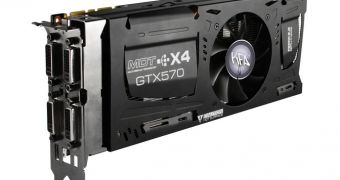KFA2 continues to expand its lineup of Nvidia GeForce solutions with multi-display support as the company has just announced a new GTX 570 graphics card which can drive up to four displays simultaneously.
KFA2 was able to overcome the limitations imposed by Nvidia's hardware by using a third-party IDT VMM1400 controller, a chip that is usually found in multi-display hub devices.
Going for a quick look, KFA2's latest creation seems to resemble the company's previous GeForce GTX 570 design as it uses the same same custom cooling solution, but which was now painted black together with the PCB for a more aggressive look.
However, unlike the other GTX 570 model in KFA2 lineup, the MDT version comes with a dual-link DVI output, a mini-HDMI port and three other DVI-D connectors, which can support up to four monitors simultaneously, double than Nvidia's reference design.
Three of the displays attached to the card can be combined to form a single surface (for multi-monitor gaming or productivity) with a resolution of 5760x1080 pixels.
Another new feature included by KFA2 in the GTX 570 MDT X4 is the so called KFA2 HT-Engine, which is a dedicated chip that can monitor the graphics card's power consumption and modify its voltage settings while also coming with a Dual BIOS feature.
“One GTX 570 – four monitors, 1080p surround gaming, Extreme over-clocked edition with a black PCB and a black matt finished quad heat-pipe cooler – say no more” said Graham Brown, European Marketing Manager.
Sadly, KFA2 hasn't provided us with any details regarding the clock speeds or the pricing of the GTX 570 MDT X4, but the card should become available later this month throughout Europe.
The GeForce GTX 570 is based on Nvidia's GF110 GPU and it packs 480 stream processors, 60 texture units, 40 ROP units and a 320-bit wide memory bus that is usually connected to 1.25GB of GDDR5 video buffer.
Nvidia's default operating frequencies are rated at 732MHz for the GPU and 950MHz (3800MHz data rate) for the memory.

 14 DAY TRIAL //
14 DAY TRIAL //